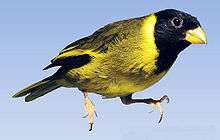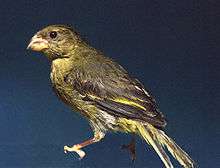Oriole finch
The oriole finch (Linurgus olivaceus) is a small passerine bird in the finch family.
| Oriole finch | |
|---|---|
 | |
| Scientific classification | |
| Kingdom: | Animalia |
| Phylum: | Chordata |
| Class: | Aves |
| Order: | Passeriformes |
| Family: | Fringillidae |
| Subfamily: | Carduelinae |
| Genus: | Linurgus L. Reichenbach, 1850 |
| Species: | L. olivaceus |
| Binomial name | |
| Linurgus olivaceus (Fraser, 1843) | |

The male has a black head, a yellow body, black flight feathers and a stout bright yellow-orange conical bill. The female is a dull greenish-olive but has black flight feathers and a yellow bill. The oriole finch is found in Africa and is native to Burundi, Cameroon, Democratic Republic of the Congo, Equatorial Guinea, Kenya, Malawi, Nigeria, Rwanda, South Sudan, Tanzania and Uganda. It lives in subtropical or tropical moist evergreen montane forests.[1][2]
The species was described by the British zoologist and collector Louis Fraser in 1843[lower-alpha 1] and given the binomial name Coccothraustes olivaceus.[4][5] The oriole finch is placed in its own monotypic genus Linurgus.[6] The exact relationship of this genus to other finch genera is unclear. In their phylogenetic analysis published in 2012, Zuccon and colleagues found that the oriole finch was a sister group to the genus Serinus.[7] This contrasts with the earlier 2009 analysis by Nguembock and colleagues which found that the oriole finch was sister to the genus Carduelis.[8]
Four subspecies are recognised:[6]
- L. o. olivaceus (Fraser, 1843) — Cameroon line ;
- L. o. prigoginei Schouteden, 1950 — Albertine Rift montane forests ;
- L. o. elgonensis van Someren, 1918 — Imatong Mountains, Kenya and Uganda ;
- L. o. kilimensis (Reichenow & Neumann, 1895) — northern Malawi and Tanzania.
Notes
- The year is given as 1842 on the title page of the volume in which the article appears but the later pages of the volume were actually published in the following year.[3]
References
- BirdLife International (2012). "Linurgus olivaceus". IUCN Red List of Threatened Species. 2012. Retrieved 26 November 2013.CS1 maint: ref=harv (link)
- Clement, Peter; Harris, Alan; Davis, John (1993). Finches and Sparrows. Princeton, New Jersey: Princeton University Press. pp. 210–211. ISBN 0-691-03424-9.
- Peterson, Alan P. "Zoonomen Nomenclatural data". Retrieved 7 July 2015.
- Fraser, Louis (1842). "Coccothraustes olivaceus". Proceedings of the Zoological Society of London. 10: 144.
- Paynter, Raymond A. Jnr., ed. (1968). Check-list of birds of the world, Volume 14. Cambridge, Massachusetts: Museum of Comparative Zoology. p. 232.
- Gill, Frank; Donsker, David (eds.). "Finches, euphonias". World Bird List Version 5.2. International Ornithologists' Union. Retrieved 5 June 2015.
- Zuccon, Dario; Prŷs-Jones, Robert; Rasmussen, Pamela C.; Ericson, Per G.P. (2012). "The phylogenetic relationships and generic limits of finches (Fringillidae)" (PDF). Molecular Phylogenetics and Evolution. 62 (2): 581–596. doi:10.1016/j.ympev.2011.10.002. PMID 22023825.
- Nguembock, B.; Fjeldså, J.; Couloux, A.; Pasquet, E. (2009). "Molecular phylogeny of Carduelinae (Aves, Passeriformes, Fringillidae) proves polyphyletic origin of the genera Serinus and Carduelis and suggests redefined generic limits". Molecular Phylogenetics and Evolution. 51 (2): 169–181. doi:10.1016/j.ympev.2008.10.022. PMID 19027082.
Further reading
- Arnaiz-Villena, A.; Moscoso, J.; Ruiz-del-Valle, V.; Gonzalez, J.; Reguera, R.; Wink, M.; Serrano-Vela, J. I. (2007). "Bayesian phylogeny of Fringillidae birds: status of the singular African oriole finch Linurgus olivaceus and evolution and heterogeneity of the genus Carpodacus" (PDF). Acta Zoologica Sinica. 53 (5): 826–834.
